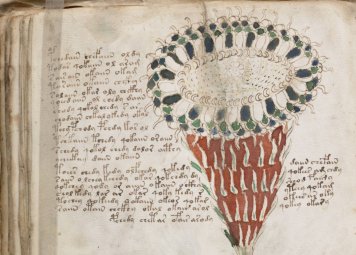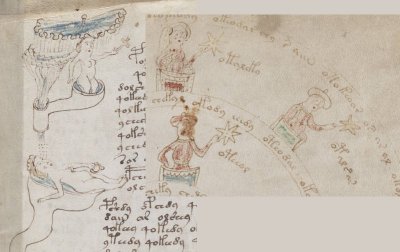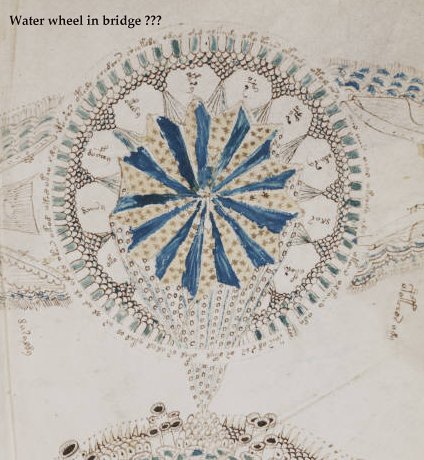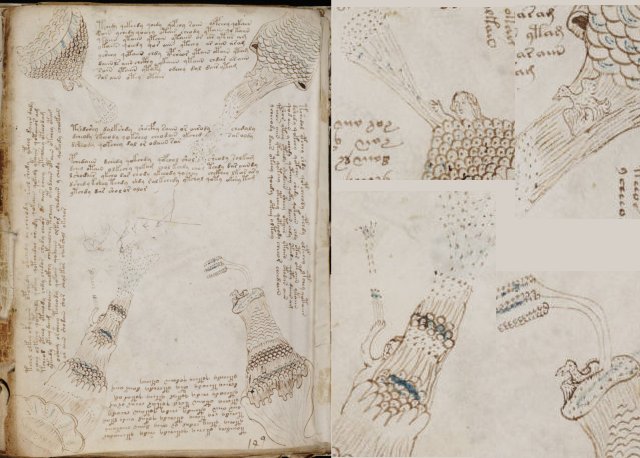The Voynich manuscript was written in an as yet unreadable script. It is named after Wilfrid Voynich, who acquired it as a dealer in 1912 from the library of Villa Mondragone, a Jesuit college in Frascati, Italy. It is now in the care of Yale Library.
In my previous articles on Yale Library's Beinebecke MS 408 I focused on its background. I am now going to discuss some basic possibilities about its unusual script. I am still working on an attempt to transcribe the text into modern English. If I succeed, my readers here at scientificblogging will be the first to know.
In my previous articles I suggested that it is a complete waste of time to try to crack a code, or read a strange script, without first obtaining some background information. In Part #1 I gave some background information about Wilfred and Ethel Voynich. I concluded that Wilfrid Voynich had no incentive to fake the manuscript. In part 2: Dating An Enigma I suggested that, from examination of some of the facts, the manuscript may date to around 1350. In Part #3 I gave more background information and suggested that the manuscript, when written, was perhaps intended as a genuine materia medica, a physician's recipe book. I also suggested that it may have been written by a woman as a medieval 'midwifery manual'.
I now give my reasons for believing that the manuscript is not written in code, but in an odd script. The underlying language will almost certainly be found to be medieval vulgate Latin.
Oddness Analysed
The first thing that strikes anyone on seeing MS 408 for the first time is its overall oddness. Nothing seems to make sense. Quite apart from the script, which matches no known alphabet, the pictures seem to be just a fantasy. Nobody has, as yet, positively identified even a single plant from its picture.

In medieval times, a physician would carry a materia medica, for three reasons I suggest. Firstly, ownership of such a book was in itself a mark of erudition, a medieval equivalent of a degree or a license to practice medicine. Secondly, the book could be shown to the - presumably illiterate - patient to illustrate some points about illness or medicine. Thirdly, the physician could consult the book for recipes and ingredients rather than memorize them.
I suggest that this particular materia medica would have served those purposes well enough and would not have appeared fanciful to a majority of people when it was written. Per contra, it would have seemed to be little out of the ordinary. I suggest that MS 408 contains a synthesis of ideas and beliefs know to most people in medieval England, France and neighbouring countries. Those ideas and beliefs were transmitted across the known world an across the centuries, losing much information in the process. It is not just in language, but also in art that we can see how ideas change and can be corrupted through the years and centuries.
In the Voynich ms is a fold-out which is often described as the 'rosettes' page. It looks very mysterious to us at first.

I suggest that any average British person of about the year 1350 would recognise it immediately for what it purported to be when drawn: a map of Baghdad. In the top left and bottom right are faint images of the sun - a convention in map-making for showing east and west. My suggestion of Baghdad, and the orientation, are supported by clues in the centre panel.

The onion domes could be representative of any country influenced by Islam. But the only circular city recorded in medieval times, as far as I can discover, is Baghdad. This Voynich panel fits a description of early Baghdad in 'History of Baghdad' by al-Khatib al-Baghdadi. The city was built to a circular plan by Abu Ja'far. Later, Al-Mansur built a surrounding wall with four gates. He added two walls, the inner wall being higher than the middle wall. Between the walls were two fasils, empty defensive areas.
There were 18 towers between each gate. The artist shows these as clusters of 6. One wall had an extra tower - shown here as an extra cluster of 6. The four gates at the north, south, east and west were domed. There was a great dome in the city, a major landmark for about 180 years, which collapsed due to heavy rain about 941 CE. Baghdad was sacked and burned in 1258.
There were defensive moats and ditches. The central palace was noted for its fine draperies. In the top left panel is a tower. This has been described by some observers as being 'in a hole'. I suggest that the inexpert drawing leads to an optical illusion: the representation is of a tower on a mound. There was such a tower in the fields outside medieval Baghdad.

I suggest that acceptance of the Baghdad theory does not automatically mean that any part of the Voynich script is Arabic or any related language. My initial assessment is that it is mainly Latin, with influences from other European languages. It was most probably written in England. There are two proofs that Baghdad was famed in England long before the Voynich ms came to be compiled.

Gold imitation dinar of Offa, King of Mercia, England, 773 - 796
Image courtesy of British Museum.
This coin was made for King Offa in imitation of a dinar of Al-Mansur, Caliph of Baghdad!
In medieval England the story of Loris and Blanchefleur was very popular between about 1200 and 1350. It is a typical European 'take' on a story of a man entering the sultan's harem by subterfuge. It is a European adaptation of a story from the Arabian Nights. From knowing this story, and from travelers' tales, the average British peasant would have heard of Baghdad, its strange onion domes, its baths and its library - called the House of Wisdom. It is said that at the sack of Baghdad, the waters of the Tigris ran black with the ink from the books dumped into it.
Now imagine a traveling physician or midwife in medieval England carrying the Voynich ms. There are many pictures of herbs, an apothecary section dealing with leaf and root preparations and aromatherapy, a balneology section and an astrological section charting the best times for conception and birth. This 'proof' that the bearer had studied medicine at the House of Wisdom in Baghdad and that they had once attended the Caliph's harem would surely increase the client fees payable!
In my next article I briefly discuss the evolution of the materia medica from its source via Europe and from its source via the islamic countries. I also show further information suggesting that the 'rosettes' part describes places and features from medieval Baghdad. The wierdness of the plants, I suggest, is a further clue pointing to the likelihood that the language beneath the Voynich text is medieval Latin.
Continued in The Voynich Manuscript part 5 : The Baghdad Connection
The Voynich Manuscript part 5 : The Baghdad Connection
The most obviously strange feature of the Voynich manuscript is its unknown script. Quite simply put, the script cannot plausibly be shown to be similar to, or derived from, any known script, ancient or modern. As a linguist I am naturally intrigued by this. As a I have repeatedly stated in this series of Voynich articles , it is futile to try to read an unknown script in an unknown language without first finding as many clues to the underlying language as possible. Seeking clues related to the herbal section of the MS I found a Baghdad connection. This led me to wonder if the central panel on the 'rosettes' page might represent Baghdad. That was the subject of my previous Voynich article. There are more connections, I suggest.
As I have stated in my articles on A Science Of Human Language and A Brief History of the English Language, languages evolve. All languages, whether written or spoken, absorb features from other languages in some proportion to geographical separation. The most striking example of this is Japanese, which uses Chinese characters as part of its writing system but contained few European words until the beginning of the 20th century.
Knowledge behaves much like language in this respect. During a period roughly between 900 and 1300 CE there was a 'knowledge gap' in most of Europe. During that period many original Greek texts were lost, and knowledge of Greek faded. Manuscripts were copied by hand. Surviving manuscripts show that the copying was done carefully in the case of the Bible, less carefully in the case of secular documents.
For all of the care taken with the Bible, distortions were introduced. In the case of other documents the distortions are glaringly obvious to modern researchers. The specific case of the materia medica of Dioscorides, 40-90 CE, is a classic example. The original work comprised five volumes. The herbal section identified many plants by characteristics and by common names, including foreign names. The original materia medica was not illustrated.
Over the years Dioscorides works were translated across many languages. Illustrated versions appeared, the pictures at first being based on the translator's best guess as to the plant described. Succeeding translators and copyists produced illustration based on a mixture of their own knowledge and beliefs, prior works and best guesses. Whilst the materia medica was a careful production in the Islamic world it had become degenerate and based on much fantasy in Western Europe.

Manuscripts do not survive unless carefully stored and handled. Down through the centuries many manuscripts have been subjected to careless storage and handling, re-use as palimpsests, or deliberate destruction by religious zealots, conquerors and even librarians1.
"The basis of the model is that manuscripts are like organisms," said John L. Cisne, a paleontologist and evolutionary biologist at Cornell University in Ithaca, New York. "A manuscript is going to behave just like an individual in a population. It can divide and reproduce or it can die."
National Geographic.
Surviving variants of the materia medica range from the merely inaccurate to the wildly fanciful. It should come as no surprise that the Voynich plants appear most odd to modern eyes. I suggest that it is a copy of a copy of a series of copies across a time-span of about 1200 years. The knowledge and myth in Dioscorides materia medica spread from Greece across Europe. It spread through the Islamic world and back to Europe via Spain, Italy and Constantinople. Along that journey through time and space there were many losses and additions
Until it was sacked by Mongols in 1258, Baghdad was a widely renowned centre of learning, with a library and an observatory. Contemporary reports of the number of public baths in medieval Baghdad vary from 2,000 to 10,000. The only reasonable course is to accept that Baghdad was famous for having enough public baths to meet the needs of its population and visitors, especially during the Hajj season.
Travellers reports indicate that the baths had separate facilities or times for men and women. In the baths, Christians had to show a cross and Jews a ring as a symbol of their dhimmi (non-islamic) status. Elsewhere, Jews wore a specific kind of headgear, the pilleus cornutus. Taken literally, that might seem to indicate a conical hat. In fact, the hat was round with a central point or 'pimple' which varied in length with fashions.

In the history of engineering, medieval Baghdad's most famous son was Al-Jazari, who wrote a treatise on mechanical engineering towards the end of the 12th century. He was famous in his own lifetime as an ingenious hydraulic engineer. In the regions of the Tigris and Euphrates the Romans had constructed canals for irrigation. Under the caliphate of Baghdad these canals were extensively improved. Waterwheels of various kinds were used to pump water up into aqueducts. The two most unusual types of waterwheel were mounted directly in the river, one type in the central pier of a bridge, the other on ships moored in the river.

Al-Jaziri invented many automatic mechanisms for the control of water flow. Most strikingly, he built a water-powered clock with moving astronomical/astrological components and animated mannequins and birds.
Al-Jazari's clocks all employed automata to mark the passage of the hours. These included birds that discharged pellets from their beaks onto cymblas , doors that opened to reveal the figures of humans, rotating Zodiac circles, the figures of musicians who struck drums or played trumpets and so on.
Source: History of Sciences in the Islamic World.
Compare that description with this Voynich page and details:

Do these Voynich features represent the clock of Al-Jaziri ?
Continued in The Voynich Manuscript part 6 : The Other Babylon
[1] "In visiting the library of the monastery, in the month of May, 1844, I perceived in the middle of the great hall a large and wide basket full of old parchments; and the librarian, who was a man of information, told me that two heaps of papers like these, mouldered by time, had been already committed to the flames. What was my surprise to find amid this heap of papers a considerable number of sheets of a copy of the Old Testament in Greek, which seemed to me to be one of the most ancient that I had ever seen."
Constantin von Tischendorf, The Discovery Of The Sinaitic Manuscript
David Cox's Online Religious Library
Beinecke's Voynich images pages:
http://beinecke.library.yale.edu/dl_crosscollex/SetsSearchExecXC.asp?src...
Useful Voynich-related sites:
(Nick Pelling's and Elmar Vogt's blogs are the most frequently updated)
http://www.ciphermysteries.com/
http://voynichthoughts.wordpress.com/
http://www.voynich.nu/roadmap.html
http://hurontaria.baf.cz/CVM/
http://www.as.up.krakow.pl/jvs/index.htm
http://www.voynich.net/
http://voynich.freie-literatur.de/index.php


No comments:
Post a Comment